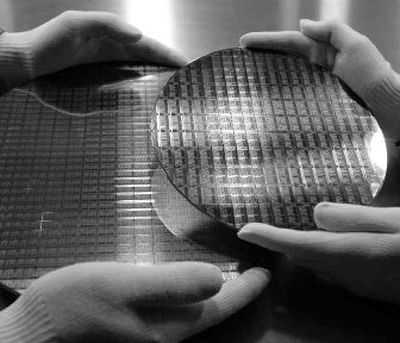Chips are falling at AMD

SAN JOSE, Calif. — The high-flying Advanced Micro Devices Inc. of 2006 has given way to a company in financial peril, saddled with debt and bleeding from a brutal price battle with its larger and suddenly resurgent Silicon Valley archrival, Intel Corp.
AMD finds itself the subject of rumors of a possible takeover or private-equity cash infusion. While it wasn’t long ago that AMD was stealing a big slice of the microprocessor market and emerging as a long-term threat to Intel, those very gains may have left AMD’s well running dry.
Though the price competition has cut into both chip makers’ profits, Wall Street has punished AMD’s stock particularly hard.
Its shares have plunged more than 60 percent over the past year on fears about the company’s ability to continue gaining share without hurting profit margins. Meanwhile, Intel’s stock is down just 4 percent.
Investors are concerned AMD is spending too heavily to keep up with Intel’s aggressive transition to next-generation manufacturing technology.
AMD’s fall has wiped out about $10 billion in shareholder wealth. Analysts say the exodus will likely continue until the company rolls out its new chips this year and resolves fears about its dwindling cash reserves and high capital expenditures.
The shifting fortunes highlight the challenges facing AMD as it squares off against a company with seven times its annual revenue and a history of spending heavily on breakthrough technologies.
“AMD, as a company, has enough strong parts that it will survive, but I think it’s going to be a rough couple of years for this organization,” said Stephen Kleynhans, a research vice president at Gartner Inc. “They’ve got some very solid technology, but technology can be very fleeting. A technology lead today can just disappear in just a matter of quarters.”
Both Intel and AMD are adept at weathering the boom-and-bust cycles of the volatile semiconductor industry. But they are still adjusting to AMD’s newfound competitiveness across a range of products, from desktops to laptops to servers.
AMD stole about 4 percent of the overall processor market from Intel in 2006, according to Mercury Research. AMD scored a particularly big victory by partnering with Dell Inc., once an exclusive Intel client.
But Intel, which still controls about three-quarters of the total market, has roared back with a lineup of powerful and energy-efficient processors that appears to be slowing AMD’s offensive.
While AMD continues to gain market share in desktops and laptops, its growth in the lucrative server market has stalled. In 2006, AMD siphoned about 5 percent of the server market from Intel, but leveled out at 22 percent share during the second half, according to Mercury Research.
Last month, Intel scored a high-profile victory of its own, announcing an alliance with server and software maker Sun Microsystems Inc. The partnership will put Intel chips back in Sun servers and workstations after several years of AMD exclusivity.
AMD is banking on regaining momentum with the mid-2007 launch of its new server chip, code-named Barcelona, which has four computing engines and an updated design. The company acknowledges that Intel beat it to market with four-core chips that launched in November. But AMD insists its design for getting the cores to communicate with each other will serve as a key advantage.
“Five years ago no one knew who we were in the server space, now we’re a player,” said Mario Rivas, AMD’s executive vice president for the computing products group. “This will allow us to be a serious contender in the server space and regain the performance crown. There is a halo effect that goes with that.”
But analysts are not optimistic about a quick turnaround for AMD.
The company swung to a $166 million loss for fiscal 2006 and disappointed investors by offering little clarity on how it intended to differentiate its products from Intel’s and improve profitability.
This week, AMD warned it was unlikely to meet its first-quarter revenue guidance of $1.6 billion to $1.7 billion.
“Our view is that this will get worse before it gets better,” said Christopher Caso, a senior analyst with Friedman Billings Ramsey. “This quarter’s performance is evidence that it did get worse.”
Wall Street is worried that AMD is in dire need of cash after its $5.6 billion acquisition of graphics chip maker ATI Technologies Inc. and heavy spending on factory upgrades.